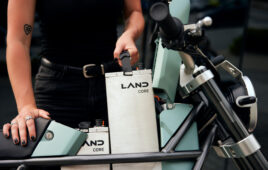Wind turbines, like helicopters, are fatigue machines—always vibrating and working to loosen their fasteners. More vibration will come as engineers develop longer blades to capture more wind energy and towers reach higher to accommodate them. These increased vibration levels may loosen some tower fasteners. To prevent this, engineers are looking for better ways to measure tension (than torque) and prevent corrosion. Finally, fastening companies are becoming more wary of costs especially as they count toward total cost of ownership (TCO).
Torque control is a risky way to achieve consistent pretension in structural bolts. It all comes down to the k-factor, the relationship between the torque applied to a fastener assembly and the actual tension reached in the bolt. K-factors range from 0.10 to 0.20.
Consider also the variability of torque tools. Actual bolt tensions vary ± 40% or more when using torque control to generate a precise load. Crews may find a better tension indicator in a direct-tension indicator that squirts. It’s a washer that tells when a target tension had been reached in a bolt, regardless of the applied torque. When the bumps on the washer sufficiently compress, a brightly colored silicone squirts from cavities under the bumps. The compression tolerance of the bumps and squirt appearance are calibrated to a required tension. GL certifies that the devices for M36, M42, and M48 bolts will reach target tension ±10%.
Other construction trends deal with ways to keep bolts tight. The spokesman for a locking disc manufacturer says a locking washer can eliminate fastening failure. “The device consists of two preassembled washer-shaped pieces that have inclined cams on one side and a series of radial ridges on the other,” he says. The cam sides are placed between the nut and joint material. The cam angle is greater than the bolt-thread-pitch angle, so the interlocking cams and non-slip ridges of the washer jam to prevent the nut from loosening under vibration.”
Tension-control bolts are replacing some conventional high-strength friction-grip versions because they are quick and easy to install with a lightweight electric shear wrench. Guaranteed tension and a visual inspection eliminates the likelihood of operator error and ensures engineers that connections are tightened according to specifications. Another perk of this bolting system is that it is easily removed and reused, which reduces costs.
Other types of secure bolts are not easily removed and must be burned or cut off, which destroys the bolt and requires purchasing a new one. White says another way to trim costs is by using an electrically powered shear wrench that’s lighter than hydraulic wrenches. It requires one worker and improves safety. The shear wrench uses two sockets that rotate in opposite directions, allowing the nut to turn while the bolt remains stationary. The counter-force operation transfers no torque to the operator, thereby reducing fatigue that can cause carpal tunnel syndrome.
Lighter and smarter wrenches are another bolting trend. While hydraulic wrenches and bolt pullers have been a mainstay in the wind industry, electric wrenches are attracting attention because of distinct advantages.
For instance, one wrench manufacturer says the margin for error is a lot less with an electric wrench because the tools can be “locked” to a particular torque value. Electric wrenches work with ±3% accuracy. In addition, torque limits on the wrenches can be set for several jobs at one time.
In addition, more bolting work asks for accountability– knowing that each bolt is tightened to a prescribed level. More wind-turbine manufactures require proof that each bolt has been installed and maintained at the appropriate torque specs to maintain the manufacturer’s warranty. Recent electric torque wrenches allow collecting such data. On-board data loggers report how many bolts have been torqued along with failed torques and over torques. Also, one engineer estimates that electric torquing takes about 33% less time than does hydraulic torquing.
The wind project manager adds that the calibration and testing capabilities exceed those of the hydraulic torque tools. Electric wrenches can allow digitally tracking all torque testing. When testing the electric wrench, data transfers to a program that logs it in a format that can be manipulated to fit one needed for the tower manufacturer’s specifications.
A few electric torque wrenches also let users tighten bolts to a torque or an angle. This simplifies work on GE rotors, says one engineer. For example, the tool could be set to 350 Nm plus 120°. Once bolt tightening begins, the gun automatically torques the bolt to 350Nm, stalls for a moment, and then move the nut 120°. This is vital to some torque procedures because it lets techs torque in a continuous motion without stopping to rely on someone’s eye to add the 120°. WPE
Windpower Engineering & Development
Filed Under: Green engineering • renewable energy • sustainability




